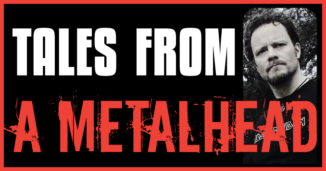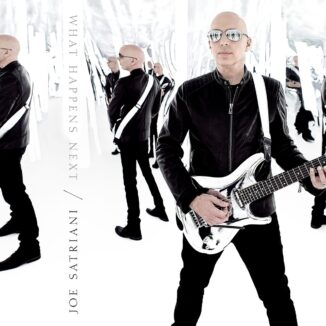
Joe Satriani’s new album Unstoppable Momentum has just been released in early 2013. Metal Express Radio chatted with him about the new album, the tour, and Chickenfoot.
Metal Express Radio: Your new album the Unstoppable Momentum has just been released in May 2013 and has already been getting some of the best reviews of your career. You must be delighted to read those?
JOE: That’s always a pleasant surprise. I try not to believe any of it, but you can’t help feeling good when you see them.
MER: It’s been three years since your last album Black Swans and Wormhole Wizards. How have the intervening years influenced your writing?
JOE: There’s been so much activity with my own band as well as with Chickenfoot (with Sammy Hagar and Michael Anthony from Van Halen, and Chad from the Red Hot Chili Peppers) that I’ve been influenced by. I even played with Sammy Hagar doing his Ronnie Montrose tribute. I also did three separate G3 tours in South America, Australia, and Europe. It was an extremely fun, artistically rewarding time and it ended with me back home for two months, which is when I sat down to write a new record. It’s been a very exciting time for me since my last album.
Musically the album sounds upbeat and less moody this time. Were you in a more positive mood frame when writing for the album?
JOE: Once I started to edit the master song list, I began to notice a trend that I liked. I tend to start out with 50 or 60 songs and start the process of elimination. When I get down to about 20 I start to see a direction that I like. When I walked into the studio with my short list of 16 songs, I was feeling uplifted and the songs seemed to be more inspiring and less brooding, so the album ended up with a more upbeat vibe to it this time.
MER: Talking of writing, how do you tend to construct your songs? AC/DC or Status Quo build things up from a simple riff, but your music is very complex. What tends to be the starting point for you when you write?
JOE: Every song seems to have an unusual creation story of its own. Some of them start with just a melody and I can be stuck with that for months. The song “Three Sheets To The Wind” had a very strong melody, but I had no intention of adding horns and honky tonk piano until the very end. That went through a very interesting arrangement process over the course of a few weeks. Other pieces were written and recorded on the spot like “I’ll Put A Stone On Your Cairn”. That was recorded very quickly in a matter of minutes and finished. So what is on the album was what I recorded the very first time.
MER: Although your music is complex, the technical side never gets in the way of strong melodies. Where many guitar-based albums can get lost in technical wizardry, you don’t. Is the melody the most important aspect of the music to you?
JOE: You’re correct there. I’m not one of those guys that is impressed with complex arrangements. I see a lot of musicians spinning their wheels trying to fill up the pages with as many ink dots as possible. It’s the easiest thing to do writing complex stuff then hiring in some guys to play it, but I get no kicks out of that, there’s no excitement or artistic satisfaction. To me I want to hear the simplest thing that’s the most devastating. That’s what I aspire to. I like to hide the technique and fool the listener into thinking that it was easy to play.
MER: The songs sound great through headphones. Do you think about how people will listen to the album once it’s finished and then record it in a certain way to enhance that experience?
JOE: I’ve learned to put that kind of attention away until the end of a project because it’s very easy and enticing to sit there and start to arrange the sound of a song before you’ve actually finished working on the song. It kind of sidetracks you and I like to keep things simple. I want the musicians to come into the studio and to hear their approaches to the songs. Then I want to listen to my engineer and co-producer to see what they bring to the party. Once I have a great melody, harmonies and a solid rhythm, then I can start to entertain the idea of how it will be fixed in the sonic stage.
MER: The title track “Unstoppable Momentum” has a touch of Rush circa Moving Pictures about it. Who influenced you as a kid?
JOE; When I was growing up I was exposed to a lot of music. I was the youngest of five kids and my parents listened to music all of the time. I grew up listening to Classical, Jazz, early Rock ‘n’ Roll, Motown, Soul, the British Invasion. You name it; it was the soundtrack of my youth. I then listened to Zeppelin, Black Sabbath, Hendrix, The Beatles, The Stones and The Doors and stuff like that. I suppose I could listen to my music and tell you bar by bar who I’m evoking. I know it’s there and my influences are all over my music. The opening song is in 5/4 and Vinnie Colaiuta’s approach to playing the drums meant that I didn’t worry about putting it on as the lead off track. Usually an odd time signature song is put somewhere safely in the middle of the record, but with Unstoppable Momentum it felt so good to me that it was perfect to open the album.
MER: “Jumpin’ In” has a wonderful Funky feel to it. You can almost imagine Larry Graham from Sly and the Family Stone locking into that groove?
JOE: It’s part of the experience of being a musician that you want to do the things that excited you most when you were young. It’s a funny set of connections, but we are all ruled by those musical influences that meant so much to us when we were coming of age. I remember hearing Sly Stone on the radio as a kid and it felt natural for me to want to make that music pump through the veins when I put on the guitar. When you get together with musicians with similar backgrounds those are the sort of things that tie us together.
MER: The following track “Jumpin’ Out” is musically very different. Why did you pair the songs together on the album in this way?
JOE: I had written two songs on the same day but I’d forgotten about the song “Jumpin’ Out” and as the weeks went on while I was working on “Jumpin’ In”, I realized there was this other file in the main Pro Tools file for “Jumpin’ In” and I opened it and thought “Wow, what is this thing?” I realized it was like the evil twin so just as I was about to go into the studio with the guys I decided to finish that as a song. They are like bookends to each other and think they work really well on the album.
MER: “Three Sheets To The Wind” is an English phrase for being blind drunk. Is this your musical interpretation of that?
JOE: It was a phrase I’d heard my parents use when I was growing up, but I didn’t know where it came from. They both grew up in New York City, so they had some powerful vocabulary. I was having a daydream one day about a young person dressed very well stepping out of their urban home … out for a night of adventure. So I wrote a song about their night out and getting back home in a tipsy or inebriated state, and the way that they would somehow skate right through the craziness of a wild night out and wind up back home safe and sound. It’s like a soundtrack to a night out.
MER: “I’ll Put A Stone On Your Cairn” is a wonderful atmospheric piece; you can almost imagine walking through the Scottish Highlands to this. What inspired you to write this song?
JOE: The song started as a strange cathartic moment where I was imagining a piece of music that would accompany someone like myself saying goodbye to the world. Then when I listened back to it I realized that’s not quite what it was. What I was saying was goodbye to somebody that you’ve lost or a group of people that you no longer see. It was more than a memorial, more than a remembrance. I recorded the melody really quickly, but let it stand there for 9 months. The song ended up being two one-take performances and I needed to come up with a phrase that captured the emotion, but not in the “you’re gone and I’m sad” type of situation. I thought the reference to I’ll put a stone on you cairn really captures the feeling. It’s upbeat but recognizes that somebody did something important for you that you are not going to forget.
MER: Your album is available in some special editions from your website, which includes an art book of your drawings. Is this the first time you’ve made your artwork available like this?
JOE: I’ve been doing it for a very long time. My sisters are artists and they were always trying to teach me to draw when I was a kid. My artwork has wound up on guitar straps, picks, CD booklets and posters. We even had some on projections for the backdrop on stage. They do look a lot better when you see them on a page. They seem diluted when they are on a guitar strap or something like that. It was an experiment to put the artwork into a book to see what it was like. I looked at a hundred of them, page after page, and I liked the experience. I thought I’d do it seriously and share it with the fans to see how they felt about it and they loved it. I’m now looking to do artwork on some kind of larger medium rather than just sketch books. I’m sure it’ll take a few years, but it is something I’d like to do.
MER: Your latest UK tour starts on June 8, 2013 in Manchester. Are you looking forward to getting back over to the UK?
JOE: I have such a great relationship with our UK fans ever since my first show at the original Marquee in London back in ’88. It always feels magical being in the UK and I love travelling up and down the country, although I can’t always understand what everyone is saying, but that’s what makes it so unique. From an American’s perspective, it’s an exotic trip.
MER: On your album you have Vinnie Colauita (drums), Chris Chaney (bass) and Mike Keneally (keyboards). Are these musicians also the nucleus of your touring band?
JOE: I was only going to be able to grab Vinnie and Chris for 7 or 8 days, so I had to think about pulling together a live band for the whole tour. As luck would have it, Bryan Beller and Marco Minnemann were both available and they are just both incredible musicians. I had to steal them away from Guthrie Govan for a little while as they are all in a band together called The Aristocrats and also Mike Keneally is currently in Deathlok, so it took a bit of negotiation to get the band together for the tour.
MER: How long before the tour do you tend to get your band together to rehearse?
JOE: We’ve just had four days of rehearsals and they were really good days. They are incredibly professional players so there’s never any technical concerns — it’s just how we gel as a band. There’s nothing better than live shows to bring people together, so you can rehearse all you want but it doesn’t start falling into place until we start playing shows on the tour.
MER: What can fans expect from your show this year? Will you be playing a good mix of new and old?
JOE: We’ll be doing all of the new album then we’re going to play all the favorites that the fans have been voting for on satriani.com. We always throw in a few unexpected songs that we pull out of the catalog. It’s a good show, it’s very exciting and we all feel challenged by the set list. It’ll be exciting for the fans.
MER: You’re also a member of Chickenfoot. Is there any word when you’ll be getting together to record your follow up to Chickenfoot III from 2011?
JOE: We’ve talked quite a bit. I was rehearsing at Sam’s studio the other week, so we were talking then and I think there’s a pretty good chance of a new Chickenfoot record and tour in 2014.
MER: After your current tour is over, what do you have planned?
MER: We’ll be in Europe and Russia until July, then we head back to The States where we’ll be touring until October. There’ll be a break in there too as The Aristocrats and Deathlok have some shows, which will give me the chance to get together with Sammy to start working on Chickenfoot material, and we’ll also be trying to fit in some dates in Asia at some point, so it’s going to be a pretty busy year for me.
See satriani.com for full details on his tour and other musical events.




Be the first to comment